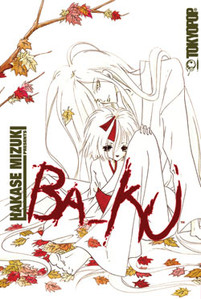Review
by Carlo Santos,Baku
GN
| Synopsis: |  |
||
Powerful spirits collide with the human world in this pair of short stories. In "Baku," a handsome young man named Takeshi knows that he has powers, but is unaware of his true nature. It's up to two mysterious figures from Takeshi's past to awaken his long-hidden memories. Then, in "Mephisto," a half-demon boy named Mephisto uses his abilities to put troubled spirits to rest. What he may not have expected, however, is that even inanimate objects can have unfinished business on this earth ... |
|||
| Review: | |||
If there's one thing Mizuki Hakase brings to the supernatural genre, it's an unflappable sense of style. Other works are more concerned about fancy effects and frightening creatures and spiritual energy—but not here, where sweeping lines and dramatic staging can be more meaningful than the story itself. Baku is a classic example of this aesthetic, although its short, self-contained length keeps it from reaching the scope of Hakase's "Demon" titles. There are flaws, naturally—an over-reliance on flashbacks, a lack of character variety, old-time genre gimmicks put to use—but they don't stop the stories from being enjoyable. Careful pacing and an understated approach take these mystical tales to a sophisticated level. The title story clocks in at just about 120 pages, giving it enough room to develop a fairly substantial plot. Takeshi's day-to-day life is quickly established, with subtle hints of what his special powers are, and the emotional trials of his mother also provide a compelling hook. However, "Baku" sags in the middle chapter as it tries to go through all manner of flashbacks to establish Takeshi's background, jumping to his origins in the spirit world, and how he was brought to earth, and what role his mother played in all this. With all this backtracking, it can be hard to tell whether a scene is taking place in the past or present—but by the final act, the storyline tightens up again with a redemptive message about familial love. A trite message, perhaps, with its reliance on a damsel-in-distress situation and past childhood trauma, but still a satisfying one. The other story in this volume, "Mephisto," is more conventional in its execution, following a typical "supernatural solver of mystery cases" format. The prologue does tie in to the second chapter, though, providing some continuity, and once again we see family ties giving the main character a little more depth than the average spirit-hunting protagonist. With its more compact plotting, "Mephisto" manages to avoid the flashback awkwardness of "Baku," while still being just as emotionally touching. Certainly, the themes of this story are universal enough that they don't require heavy character development—the vengeful regrets of a young woman, or the poignancy of growing up and leaving cherished things behind. Sure, it's the kind of stuff we've all seen before, but again, there's nothing wrong with seeing familiar themes done well. Stylish artwork is another big selling point for Hakase's works, and this one is no different. High fashion and glamour come to the spirit world with slim, impeccably dressed bishounen and dreamlike young women. The only problem: swishy linework and sparse details make it hard to tell some of the characters apart. (At least Mephisto wears a very distinctive outfit.) On the other hand, the one thing that most often leads to confusion in other "stylish" manga—page layout—actually works very well, thanks to a strong use of blank spaces and wide paneling. There's no feeling of crowding or unevenness here; every scene flows effortlessly into the next, and the plain backgrounds, which would probably be criticized anywhere else, give the stories a surreal effect. Through it all, Hakase's technique brims with emotional expressiveness: the look in a character's eyes, the tilt of a mouth, or even just the curl of a line can say all that needs to be said—anger, sadness, peace, and everything in between. It's a good thing that a picture says a thousand words, because these stories are pretty light on dialogue, and what dialogue there is doesn't say a whole lot. Most of it is just there to set up the premise or advance the story, with splashes of internal thought to set the mood. The translation is fairly straightforward, getting the feelings and situations across, although it trips up a little in one scene where a character speaking archaic dialect shows up. Sound effects are sparse—this is kind of a "quiet" title, save for some action scenes—so leaving them untranslated isn't too much of a big deal here. Also, don't expect any bonus content in this volume, not even an author's note. The stories in Baku can be poignant, even tragic at times, but somehow they always finish with a calming effect, a sense of equilibrium. Perhaps that equilibrium comes from spirits coexisting with the human world, or more simply, a balance of happiness and sadness. There's plenty of both in this short collection, along with themes of love, loyalty, and the struggle for peace with one's self. The paths that the stories follow may be ordinary, but the feelings within them are not, often reaching an expressiveness that only the artwork can bring out. What a surprise to learn that otherworldly creatures can also experience life on a very human level. |
|
The views and opinions expressed in this article are solely those of the author(s) and do not necessarily represent the views of Anime News Network, its employees, owners, or sponsors.
|
| Grade: | |||
Overall : B
Story : B-
Art : A-
+ Stylish, eye-catching artwork coupled with stories of subtle poignancy. |
|||
| Production Info: | ||
|
Full encyclopedia details about Release information about |
||